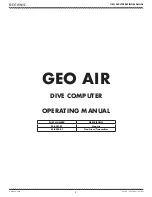
Measurement Considerations
F-13
High resistance measurements
Ohms measurement methods
The SourceMeter can make ohms measurements by either sourcing current, measuring volt-
age (constant-current method), or sourcing voltage, measuring current (constant-voltage
method). After the appropriate voltage and current readings are acquired, the resistance reading
is calculated using Ohms Law (R = V/I).
When using the constant-current method, the SourceMeter outputs a precise current and
then measures the voltage across the DUT. For high-impedance DUT, the considerations for
“
High-impedance voltage measurements
”
apply.
When using the constant-voltage method, the SourceMeter outputs a precise voltage and
then measures the current through the DUT. For high-impedance DUT, the considerations and
techniques for
“
Low current measurements
”
apply.
Characteristics of high-valued resistors
Resistors with values of 1G
Ω
or more are often referred to as megohm resistors. Because of
their high resistances, these components are very unusual devices; accordingly, there are a
number considerations to take into account when measuring these devices: voltage and temper-
ature coef
fi
cients, the effects of mechanical shock, and contamination.
Two types of high-megohm resistors are widely used: carbon-
fi
lm and metal-oxide.
Although other types are available, experience has shown that these two are the most useful.
Compared to conventional resistors, carbon-
fi
lm high-megohm resistors are noisy, unstable,
have high temperature coef
fi
cients, display high voltage coef
fi
cients, and are very fragile.
Recent developments in metal-oxide types have resulted in resistors with much lower voltage
coef
fi
cients, as well as improved temperature and time stability. Modern devices exhibit volt-
age coef
fi
cients less than 5ppm/V and no signi
fi
cant drift after
fi
ve years of tests. Temperature
coef
fi
cients are on the order of 0.01%/
˚
C at 100M
Ω
, 0.025%/
˚
C at 100G
Ω
.
Such delicate devices require extreme care in handling. Mechanical shock may signi
fi
cantly
alter the resistance by dislodging particles of the conductive material. It is also important that
the resistance element or the glass envelope that surrounds it not be touched; doing so could
change its resistance due to the creation of new current paths or small electrochemically gener-
ated currents.
The resistors are coated to prevent water
fi
lms from forming on the surface. Therefore, if it is
suspected that the resistor has acquired surface
fi
lms from careless handling or deposits from
air contaminants, it should be cleaned with a cotton swab and methanol. After cleaning, the
resistor should be dried in a low-humidity atmosphere for several hours to allow any static
charges to dissipate.
Содержание 6430
Страница 26: ......
Страница 32: ......
Страница 78: ...2 14 Connections ...
Страница 98: ...3 20 Basic Source Measure Operation ...
Страница 138: ...5 30 Source Measure Concepts ...
Страница 156: ...6 18 Range Digits Speed and Filters ...
Страница 168: ...7 12 Relative and Math ...
Страница 176: ...8 8 Data Store ...
Страница 202: ...9 26 Sweep Operation ...
Страница 248: ...11 22 Limit Testing ...
Страница 310: ...16 6 SCPI Signal Oriented Measurement Commands ...
Страница 418: ...17 108 SCPI Command Reference ...
Страница 450: ...18 32 Performance Verification ...
Страница 477: ...A Specifications ...
Страница 489: ...B StatusandErrorMessages ...
Страница 498: ...B 10 Status and Error Messages ...
Страница 499: ...C DataFlow ...
Страница 503: ...D IEEE 488BusOverview ...
Страница 518: ...D 16 IEEE 488 Bus Overview ...
Страница 519: ...E IEEE 488andSCPI ConformanceInformation ...
Страница 523: ...F MeasurementConsiderations ...
Страница 539: ...G GPIB488 1Protocol ...
Страница 557: ......
















































